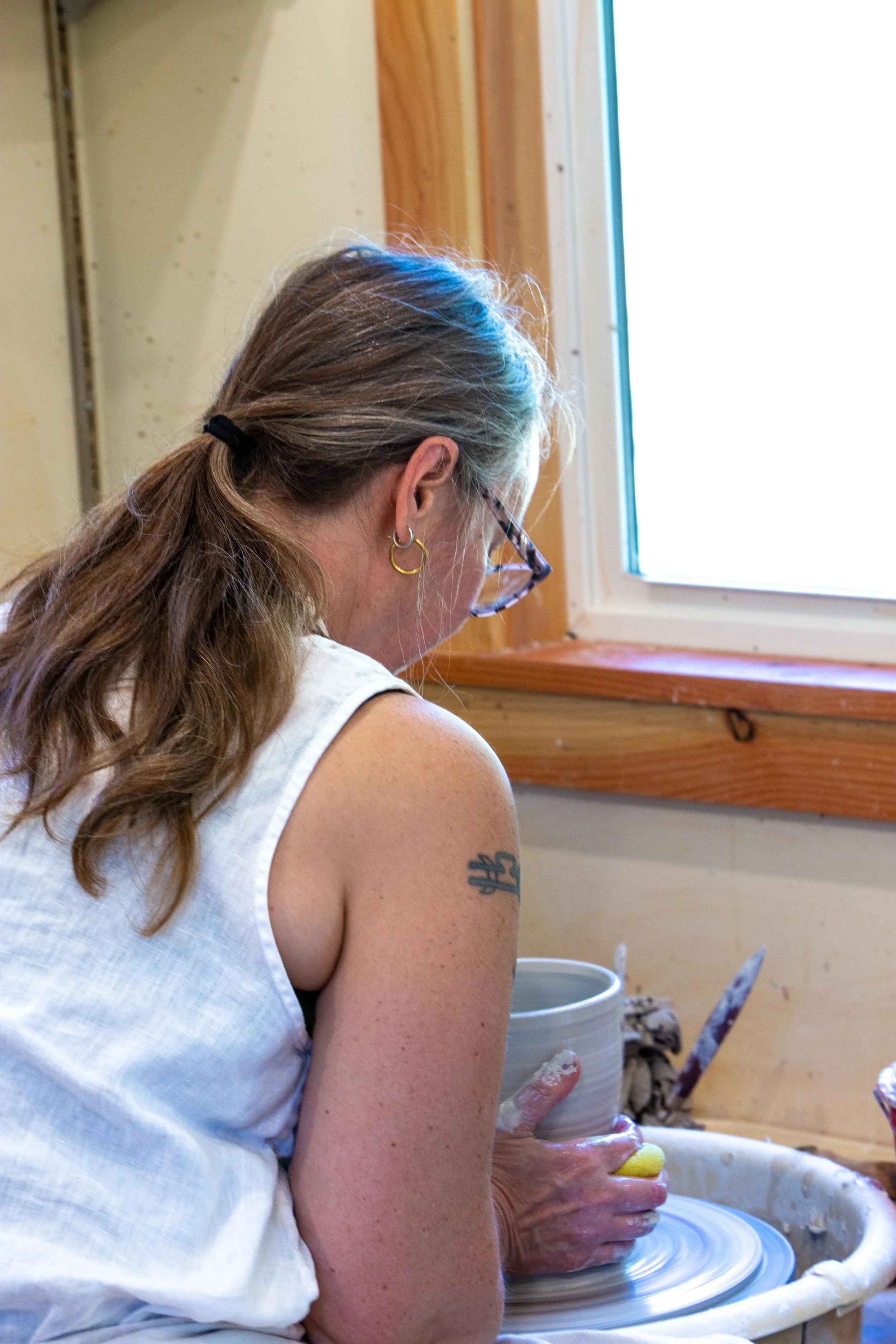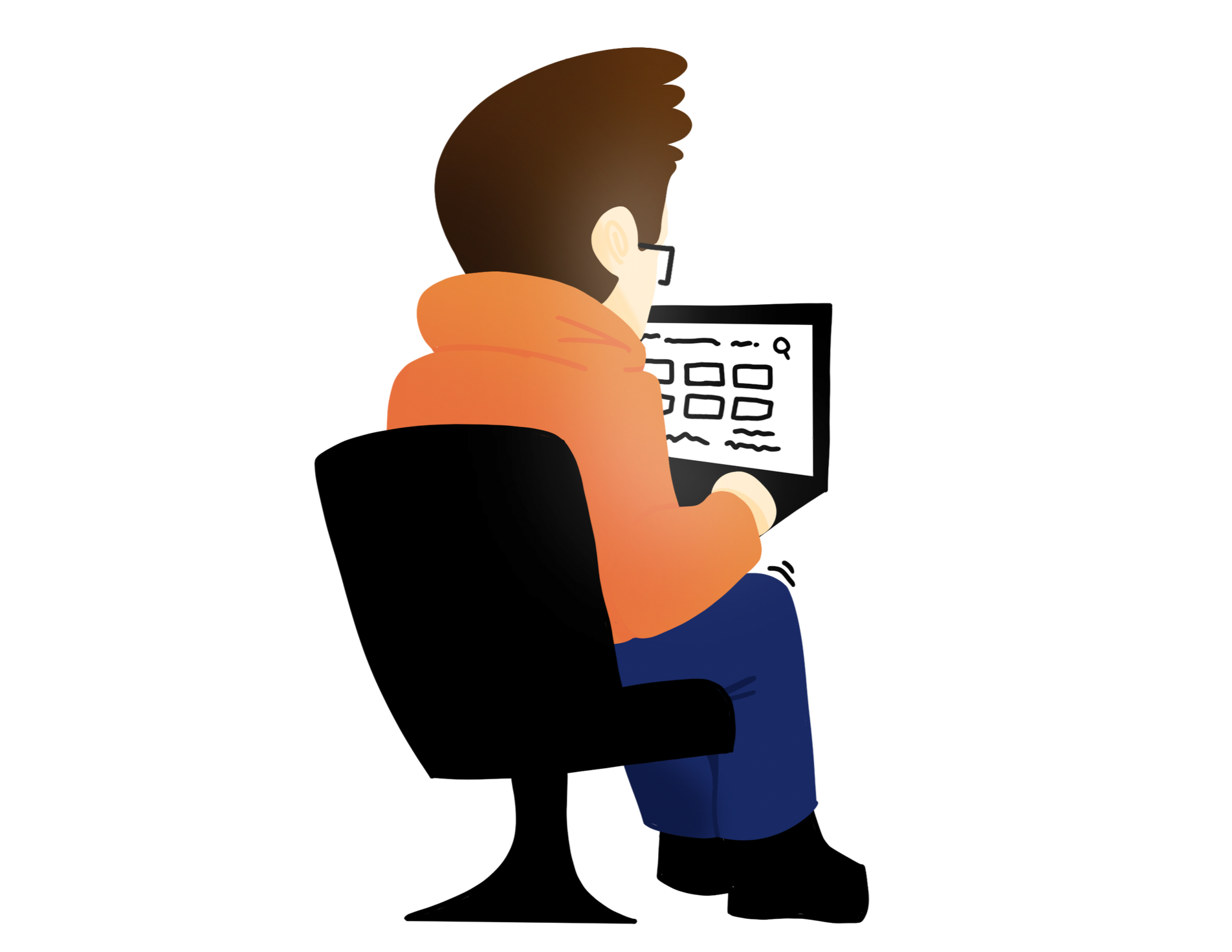SEO Basics for Musicians, Artists, and Creators
Kim from Milkstone Ceramics working on a pottery piece.
When you're a creator, the last thing on your mind is writing for search engine optimization (SEO). You want to be doing the thing that brings you joy and fills you with energy, like performing for an audience, throwing acrylic on some canvas, or methodically crocheting your latest stuffed creation. What you don't want to be doing is keyword research, configuring HTML correctly, or optimizing images.
The truth of the matter is that when you are starting out, you need to wear many hats, and a marketer is just one of them. So put your violin down, put your notifications on do-not-disturb, and open whatever writing app gives you the least amount of anxiety. We're going to go over the basics.
1. Content
Content is the foundation of SEO. Without it, search engines have nothing to index, and your audience has nothing to discover. It can come in many flavors, form main pages of your website, such as your homepage, to blog posts (like this one), to more detailed information like an extensive about page that covers the history of your band.
1.1 Content Length
The internet is crowded with short blurbs and quick posts. While there’s nothing wrong with a two-sentence Instagram caption, Google favors content that demonstrates depth and expertise.
- Aim for at least 500–800 words for blog posts. This gives you enough space to cover a topic meaningfully.
- Long-form content (1,500+ words) often performs even better for competitive topics, but don’t add fluff just for length.
- Mix it up. A musician might publish short gig announcements (300 words) and also maintain a long-form article like “The Story Behind My Album” (1,500 words).
The key is value. Ask yourself: will someone walk away knowing something new, inspired to act, or feeling more connected to you?
2. Linking
Links are like the highways of the internet—they connect your content to the larger web. When Google first launched, they discovered that the best way to tell which pages were valuable was by tracking how many links were pointing to different pages. The more links pointing at a site or page the higher that site or page would rank on Google search for keywords used in the links or on the page.
There are three main types of links when it comes to your website, based on where they are pointing:
- Internal Links: These connect one page of your site to another. Example: on your “New Album” page, link to your “Tour Dates” page. This helps search engines understand site structure.
- External Links: These point to other websites. Link to sources of inspiration, reviews of your work, or press mentions. It builds credibility.
- Backlinks: When other sites link to you, it’s like a vote of confidence. We’ll cover this more in the advanced section.
Tip: Use descriptive text. Instead of “Click here,” write “Read more about my creative process.”
3. Formatting
SEO isn’t just about what you write—it’s about how it’s presented. Website are made up of HTML, with semantic meaning. The code tells Google, as well as screen readers, what the structure of your content is. It’s important to use formatting correctly.
3.1 Headings
Headings (H1, H2, H3, etc.) are your content’s skeleton. They make it scannable for humans and understandable for search engines.
- One H1 per page (usually your title).
- Use H2s for major sections (like “Image Optimization”).
- H3s and H4s for sub-sections (like “Alt Text”).
Think of it like a set list for your show—you wouldn’t jumble songs randomly, you’d guide the audience through an experience. Don’t just change a heading from an h3 to an h1 because you want it to be a different size. You can do that with styling while maintaining the heading structure.
3.2 HTML Structure
Even if you’re not a coder, pay attention to your platform’s editor. You can often see the content directly as code. Take a dive into the HTML. It’s actually pretty straightforward.
- Paragraphs. These should be wrapped in <p\ data-preserve-html-node="true"> tags, and are the majority of the content on a page that is not your homepage.
- Bullet points and numbered lists. These should be formatted with the appropriate HTML as well, <ol\ data-preserve-html-node="true"> ordered list, and <ul\ data-preserve-html-node="true"> unordered list respectively.
- Bold or italicize sparingly for emphasis. For the most part I would try to avoid italics as it makes it harder to read. Instead, go for bold or quotes if you want to add emphasis.
A clean structure will make your content easier to read for everyone, and help your SEO as well!
4. Image Optimization
A cartoon illustration of Liv cutting physical film.
Artists and musicians often rely on visuals, but images can slow down your site if not optimized. Slow sites lead to both a bad user experience and poor SEO, as Google reduces your authority if you don’t pass certain metrics. I can’t count the number of times I have found a 10 megabyte image on a site even after I have educated the publisher that you need to keep those images small.
4.1 Sizing
Upload images sized appropriately for the web. A 5MB photo from your DSLR might look beautiful, but it will tank your page speed. Resize to around 1200px wide for most blog uses and compress it. It should not be more than 250KB.
4.2 Format
- JPEGs for photos.
- PNGs for graphics with transparency.
- SVG for icons and logos.
- WebP for modern browsers (smaller size, high quality).
4.3 Alt Text
Alt text describes the image for people using screen readers and for search engines. When creating alt text, thing of how you would describe the image to someone who cannot see.
Example:
Representation of changing ALT text in an image.
Instead of “IMG_2451.jpg,” write: “Musician playing violin under stage lights during Portland concert.”
This boosts accessibility and SEO.
5. Video Embeds
Video is a huge part of creative work; music videos, painting tutorials, performance clips, etc. First, you will likely offload these videos to a third party platform, like YouTube or Vimeo. You can then embed these video’s on your website. Then there are a few things to make these videos more accessible and SEO friendly.
5.1 Transcripts
Include a transcript of the video. It makes your content accessible and provides searchable text for Google. There are quite a few good tools out there to help with this, including Descript, Riverside, or Evernote. Make sure to review and clean up the transcription after you generate it as even the best tools make mistake and can have difficulty with heavy accents.
5.2 Closed Captioning
Similar to transcribing tools, platforms like YouTube generate captions, but they’re often inaccurate. Editing captions ensures accessibility for your audience and improves SEO because keywords are captured correctly.
6. Meta Data
Metadata is the behind-the-scenes information that search engines read to understand your page. It is what you see when you search Google.
6.1 Page Titles
Your title tag is what shows up in Google search results.
- Keep it under 60 characters. More than this and the title can get cut off in search results.
- Make it clear and specific: “Portland Indie Musician – New Album Release 2025.”
6.2 Meta Descriptions
This is the short blurb under your title in search results.
- Keep it under 160 characters. Again, longer than this and it can get cut off in search results.
- Use action-oriented language: “Listen to my latest Celtic album, inspired by the fusion of the Pacific Northwest and Bag Pipes. Stream now!”
I have seen so many sites that skip meta descriptions and titles. Don’t skip this. It’s your first impression.
Encore: SEO Optimization (Advanced)
A cartoon illustration of Jonathan pointing at a white board.
Once you’re comfortable with the basics, you can go deeper. And deeper. And deeper. SEO is the kind of thing you can constantly be tweaking, so set aside a set amount of time for it, but don’t go overboard.
1. Keyword Research
Keywords are the phrases people type into Google. Your job is to match your content with what your audience is searching for.
- Use free tools like Google Keyword Planner or Ubersuggest to brainstorm.
- Think about long-tail keywords: instead of “art,” target “abstract acrylic paintings Portland.”
- Avoid stuffing keywords unnaturally. Write for humans first.
2. Pillar Page Development
Pillar pages are a strategy to create interwoven content structure around a particular topic. The pillar page is a long, comprehensive guide on a core topic, with links to smaller related posts.
Say you want to be known for a particular type of art that is becoming a new trend. A pillar page strategy would include one large page that covers the art in general, while there would be supporting pages on things like techniques, materials, and the history of the art form. These pages then link between each other and to other pages on your site to create a all encompassing pillar of content.
Examples:
Pillar Page: The Complete Guide to Celtic Music Traditions Cluster Posts:
- The History of Celtic Harp Music
- Irish Session Tunes Every Musician Should Know
- Bagpipes vs. Uilleann Pipes: What’s the Difference?
- Top Celtic Festivals in North America and Europe
- The Role of Music in Celtic Storytelling and Mythology
Pillar Page: Life in the Court of Mary, Queen of Scots Cluster Posts:
- What Did Nobles Wear in 16th Century Scotland?
- Foods of the Renaissance: Feasts, Fasts, and Everyday Meals
- The Role of Music and Dance in the Royal Court
- Famous Battles and Their Re-Enactments Today
- How Historical Re-Enactments Keep Culture Alive
Pillar Page: The Tradition of Handmade Crafts Across Cultures Cluster Posts:
- The History of Crochet and Its Modern Revival
- Weaving as Storytelling: From Celtic Tartans to Navajo Textiles
- Sustainable Crafting: Using Recycled and Natural Materials
- Craft Fairs in the Pacific Northwest: A Complete List
- Why Handmade Matters in a Mass-Produced World
These pages build authority on your site and increase engagement as your audience reads individuals pillar pages and then digs deeper into individual topics.
3. Backlink Building
Backlinks are essential for SEO growth. They tell search engines, “Other people think this site is valuable.” Again, this is how Google first developed its ability to find the best stuff on the internet.
Here are some great ways for artists to earn backlinks to their sites:
- Collaborate with other artists and exchange blog features. You link to your collaborator’s site and vice versa.
- Submit your work to online galleries or indie music blogs. These blogs can then link back to your site with backlinks.
- Guest post on relevant sites. This will increase your credibility in the field and can earn you links back to your own domain.
Avoid spammy link-buying schemes. Search engines can penalize you for it.
4. Optimization Tools
Finally, let’s talk about tools that make SEO less overwhelming. The tools help you research how much traffic keywords get, help develop content for pillars and blog posts, and can even identify backlinks to your sites and if you lose them.
4.1 SEMrush
A powerhouse platform for keyword tracking, competitor research, and site audits. Paid, but robust.
4.2 Ahrefs
Excellent for backlink analysis and keyword research. If you want to see who’s linking to your competitors, this is the tool.
4.3 SiteImprove
Great for monitoring accessibility, broken links, and overall website health. Especially useful for creatives managing their own sites.
SEO for a Standing Ovation
SEO may sound like a corporate buzzword, but for musicians, artists, and creatives, it’s simply about making your work easier to discover. You don’t have to master every tactic overnight. Start small: write meaningful content, add alt text to your images, and fill out your meta descriptions.
Over time, these habits compound. Your art deserves to be seen, and SEO is one of the most sustainable, cost-effective ways to make that happen.
So the next time you put down your paintbrush or guitar, take 30 minutes to tweak your website. The future version of you, the one playing to a packed room, selling out your prints, or shipping custom commissions worldwide, will thank you.
A cartoon illustration of Jonathan sitting at a laptop.





